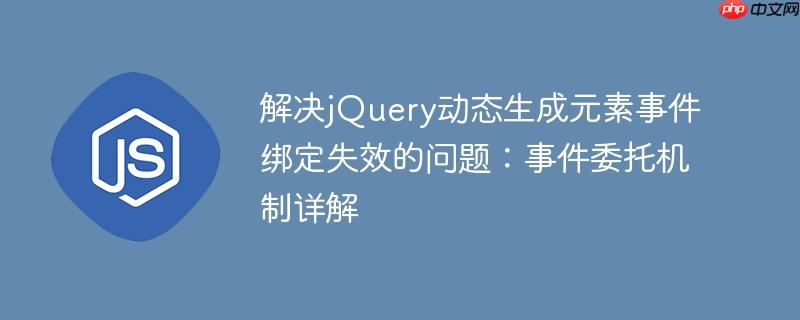
本文旨在解决jquery中动态加载内容后事件绑定失效的常见问题。通过深入剖析事件委托(Event Delegation)机制,我们将学习如何利用$.on()方法将事件监听器绑定到静态父元素,从而确保对dom动态添加的子元素也能正确响应用户交互,提升代码的健壮性和可维护性。
理解动态内容事件绑定失效的根源
在前端开发中,我们经常需要从服务器异步加载数据,并根据数据动态生成html元素。一个常见的陷阱是,当尝试为这些动态生成的元素绑定事件时,发现事件监听器并未生效。例如,考虑以下场景:
$.getJSON('/assets/data/maindata.json', function(bpds) { let mainProductCard = ''; // 使用let或const声明变量 bpds.forEach((data) => { // 动态生成包含按钮的html字符串 mainProductCard += '<div class="Qlty"><button value="'+ data.customFields[0].value +'">Ordinary</button><button value="'+ data.customFields[1].value +'">Premium</button></div>'; }); // 将生成的HTML添加到DOM中 $('#mainDiv').append(mainProductCard); }); // 在getJSON回调外部直接绑定事件 $(".Qlty button").click(function() { alert("alert working"); });
上述代码的问题在于,当$(“.Qlty button”).click()这行代码执行时,$.getJSON请求可能尚未完成,或者即使完成了,$(‘#mainDiv’).append(mainProductCard)也可能尚未执行,导致DOM中尚不存在类名为Qlty的div及其内部的button元素。因此,$(“.Qlty button”)选择器在执行时找不到任何匹配的元素,事件监听器自然无法绑定到这些未来才出现的按钮上。
解决方案:利用事件委托(Event Delegation)
为了解决动态生成元素事件绑定失效的问题,jQuery提供了强大的事件委托机制。事件委托的核心思想是,不直接将事件监听器绑定到目标元素上,而是将其绑定到目标元素的某个静态祖先元素上。当事件在目标元素上触发时,它会沿着DOM树向上冒泡,直到被祖先元素捕获。祖先元素接收到事件后,会检查事件的实际发起者(event.target)是否符合特定的选择器,如果符合,则执行相应的回调函数。
jQuery的$.on()方法提供了实现事件委托的强大能力。其语法如下:
$(staticAncestor).on(eventName, selector, handlerFunction);
- staticAncestor: 一个在页面加载时就存在的DOM元素,它是所有动态生成目标元素的共同祖先。
- eventName: 要监听的事件类型,例如’click’、’mouseover’等。
- selector: 一个选择器字符串,用于匹配实际触发事件的动态子元素。
- handlerFunction: 事件触发时执行的回调函数。
修正后的代码示例
将上述问题的代码修改为使用事件委托,可以确保动态生成的按钮也能正确响应点击事件:
$.getJSON('/assets/data/maindata.json', function(bpds) { let mainProductCard = ''; bpds.forEach((data) => { mainProductCard += '<div class="Qlty"><button value="'+ data.customFields[0].value +'">Ordinary</button><button value="'+ data.customFields[1].value +'">Premium</button></div>'; }); // 将生成的HTML添加到DOM中 $('#mainDiv').append(mainProductCard); // 在这里使用事件委托绑定点击事件 // 将事件监听器绑定到静态存在的父元素'#mainDiv'上 // 当'#mainDiv'内部的'.Qlty button'被点击时,事件会被捕获并执行回调 $('#mainDiv').on('click', '.Qlty button', function() { alert("Alert working for dynamically added button!"); console.log("Button value:", $(this).val()); // 获取被点击按钮的值 }); });
在这个修正后的版本中,$(‘#mainDiv’).on(‘click’, ‘.Qlty button’, function() { … });这行代码在$(‘#mainDiv’)元素被填充内容之后立即执行。由于#mainDiv是一个在页面加载时就存在的静态元素(假设它在HTML中是预先存在的),所以事件监听器能够成功绑定到它身上。当用户点击任何一个动态生成的.Qlty button时,点击事件会冒泡到#mainDiv,然后由#mainDiv判断事件源是否为.Qlty button,如果是,则执行alert函数。
注意事项与最佳实践
-
选择合适的静态祖先元素:
- 选择离目标动态元素最近的静态祖先元素,可以减少事件冒泡的路径,从而提高性能。
- 避免将所有事件都委托到document或body上,除非没有更具体的静态祖先可用,因为这会导致更多的事件处理开销。
- 确保你选择的祖先元素在页面加载时就已存在,并且不会被动态移除或替换。
-
理解this上下文:
- 在事件委托的回调函数中,this关键字仍然指向实际触发事件的元素(即event.target,如果它匹配了选择器),而不是绑定事件的祖先元素。这使得在回调中可以直接操作被点击的动态元素。
-
性能考量:
- 事件委托通常比为每个动态元素单独绑定事件更高效,因为它只需要一个事件监听器来管理多个(甚至无限个)子元素的事件。
- 然而,如果选择器过于复杂或祖先元素包含大量子元素,每次事件冒泡检查选择器可能会有轻微的性能影响。在大多数实际应用中,这种影响可以忽略不计。
总结
事件委托是处理动态生成DOM元素事件的黄金法则。通过将事件监听器绑定到静态祖先元素上,并利用jQuery的$.on()方法指定一个选择器来匹配目标子元素,我们可以优雅且高效地解决动态内容事件绑定失效的问题。这种模式不仅提高了代码的健壮性和可维护性,也优化了性能,是现代前端开发中不可或缺的技能。掌握事件委托,能够帮助开发者构建更加灵活和响应式的Web应用程序。


评论(已关闭)
评论已关闭